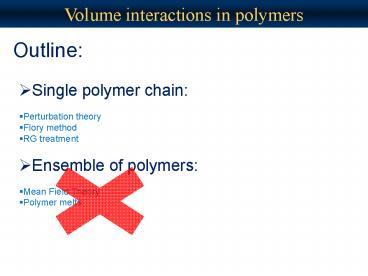Volume interactions in polymers - PowerPoint PPT Presentation
1 / 13
Title:
Volume interactions in polymers
Description:
For a polymer In a good solvent, volume interactions are ... The polymer 'forgets' about. bare parameters. Renormalization group and e-expansion (III) ... – PowerPoint PPT presentation
Number of Views:19
Avg rating:3.0/5.0
Title: Volume interactions in polymers
1
Volume interactions in polymers
Outline
- Single polymer chain
- Perturbation theory
- Flory method
- RG treatment
- Ensemble of polymers
- Mean Field Theory
- Polymer melts
2
Perturbation theory for volume interactions
For a polymer In a good solvent, volume
interactions are characterized by a single
parameter (except near ?-point)
3
Perturbation theory for volume interactions (I)
The perturbative series is an expansion in the
parameter
Physically, it is the average number of two-body
collisions taking place in the entire polymer
volume
Perturbation theory is justified when none of the
polymer segments is likely to collide with the
other segments. This situation is very different
from that for an imperfect gas.
4
Perturbation theory for volume interactions (II)
Greens function for a (Gaussian) chain
For a noninteracting chain
For a noninteracting chain in an external
potential
5
Perturbation theory for volume interactions (III)
Adding interactions
We will model short-range repulsion with
And
- Using the above constructions we need to
calculate - Perturbative end-to-end distance
- Interaction between two chains
6
Perturbation theory for volume interactions (IV)
Perturbative end-to-end distance
7
Perturbation theory for volume interaction (V)
Second virial coefficient for a polymer solution
8
Florys approach
When z is large, perturbation theory breaks down,
and Florys argument is a naïve way to calculate,
say, mean end-to-end distance for zgtgt1.
One treats a polymer as a sphere with a radius R,
and links as an interacting gas
But that is about all you can get reasonably
accurately from FA
9
Renormalization group and e-expansion
The Idea(s) 1. (Kadanoff) Look at blocks of
links, and seek for large scale behavior
only 2. (Wilson and Fisher) In d4 a polymer
is ideal, so formally perturb around d4
to get results for lower dimensions
Decimation procedure for g3, taken from
GrosbergKhokhlov
Gaussian pieces
10
Renormalization group and e-expansion (I)
RG equations
11
Renormalization group and e-expansion (II)
Equation for the dimensionless interaction
parameter
This equation has a fixed point
The polymer forgets about bare parameters
12
Renormalization group and e-expansion (III)
RG equations in a continuous form
(taken from GrosbergKhokhlov)
13
Renormalization group and e-expansion (IV)
Critical exponents (end-to-end CE)
(taken from GrosbergKhokhlov)































